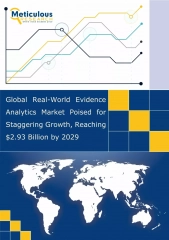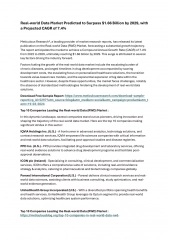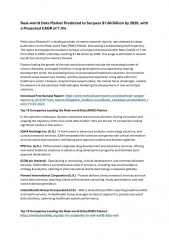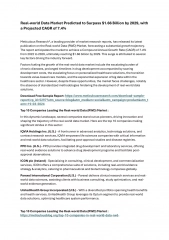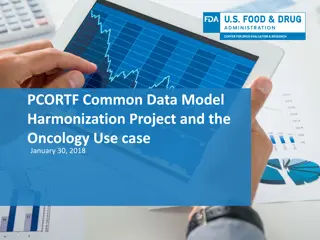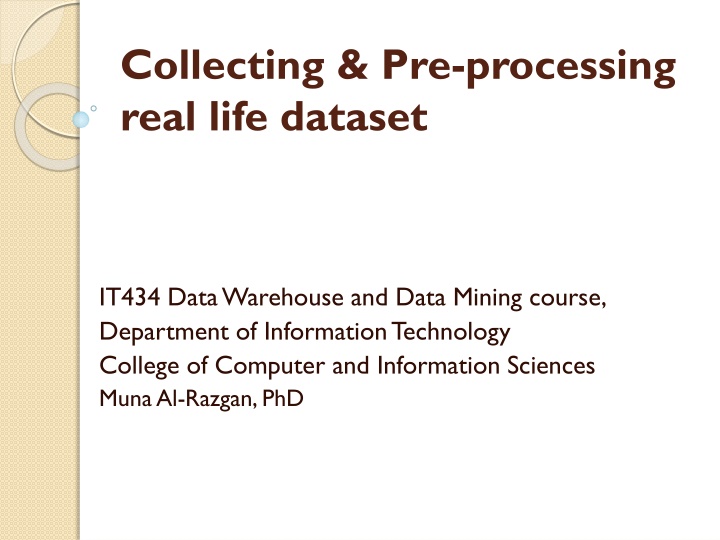
Collecting and Pre-processing Real-Life Dataset for Data Mining Course
Explore the process of collecting and pre-processing real-life datasets in the IT434 Data Warehouse and Data Mining course. Discover the motivation, objectives, challenges, and recommendations involved in this practical project to enhance students' learning experience.
Download Presentation

Please find below an Image/Link to download the presentation.
The content on the website is provided AS IS for your information and personal use only. It may not be sold, licensed, or shared on other websites without obtaining consent from the author. If you encounter any issues during the download, it is possible that the publisher has removed the file from their server.
You are allowed to download the files provided on this website for personal or commercial use, subject to the condition that they are used lawfully. All files are the property of their respective owners.
The content on the website is provided AS IS for your information and personal use only. It may not be sold, licensed, or shared on other websites without obtaining consent from the author.
E N D
Presentation Transcript
Collecting & Pre-processing real life dataset IT434 Data Warehouse and Data Mining course, Department of Information Technology College of Computer and Information Sciences Muna Al-Razgan, PhD
Outline Introduction Motivation Project Objectives Collecting & Pre-processing real life dataset Process Open source software: Open Refine Results and effectiveness of the Projects Project Applications and teaching and learning sustainability Obstacles and Challenges Recommendations
Introduction Data mining: is the Knowledge Discovery in Databases KDD process. The overall goal of the data mining process is to extract information from a dataset and transform it into an understandable structure for further use. The KDD process consists: data pre-processing (data cleaning, data integration, data selection, data transformation), data mining (model and inference considerations), pattern evaluation of (identify truly interesting patterns), and finally knowledge discovery and representation.
Motivation: One of the main steps in (KDD) process is getting the pre-process and correct data. In our course we have two extended chapters that address the need for cleaning and preparing the data. the web has many ready-to-use dataset, but using any of them, will not help the students gain real experience of collecting and pre-processing real life dataset. The project idea is formulated: collecting and pre-processing real-life dataset
Project Objectives Tell me and I will forget. Show me and I may remember. Involve me and I will understand. ~Chinese Proverb Apply the concept of learn-by-doing: Collect and pre-process real-life dataset from our community; Analyze the dataset to discover useful knowledge. Collect grocery dataset from receipt purchases from local supermarkets. Enhance team-work skills among computerize students: collect & pre-process as student-group and then prepare a report. The idea was transfer the theory of data pre-processing in the IT434 course into practical project. Collecting & pre-processing real dataset
Project Objectives Gather real life from local supermarket and collect it as class-project Students will encounter there are much irrelevant, noise, missing values, and redundant information in the collected data. Students will encounter how real life is dirty Data pre-processing includes cleaning, normalization, transformation, feature extraction and selection.
Project Objectives By applying our project students will: Learn-by-doing: one of the main steps in KDD process Improve knowledge comprehension instead of reading or memorizing Attract student s interest and hopefully lead to increase knowledge retention Promote more interaction and student-driven discussion Enhance teamwork skills among computerize students Build real life repository from our society, then analyze the dataset to discover the hidden knowledge for our community and culture.
Collecting & Pre-processingreal life datasetProcess: Explain the idea of building real life repository Explain the idea of pre-processing process to real life dataset Choose the appropriate dataset that is from Saudi community such as as mini-market at Malaz campus . Discuss the important features or attributes needed for the repository in the classroom Compile the important features and post it in a Google-doc Asked each student to collect data and post it to the Google-doc. Allowed a specific time-frame to collect the dataset (during Hajj break) Discuss the gathered dataset in classroom, and ask the student to express their feedback and opinion in Blackboard
Collect & Pre-process real life datasetProcess: (2) Students will discover the data is not ready and need a lot of cleaning pre-processing Each group of students will perform pre-processing on the dataset during lab hours. Student-groups use Learning management system (Blackboard) to share their contribution to clean the data such as date format, consistency of monetary value, and filling missing values. Student-groups used open-source software called Open- Refine to pre-process the dataset, Open Refine: A free, open source, powerful tool for working with messy data The dataset will be ready, and be used to apply data warehouse and data mining techniques. And also, can be donate it to the open source dataset under King Saud university ownership. Analyze the result using data mining techniques to discover the gold and hidden knowledge in the data
Results and effectiveness of the Projects Aristotle stated, One must learn by doing the thing, for though you think you know it, you have no certainty until you try. Help students to be-part of the learning process not as passive and receive knowledge Improve students grade since the grade distribution not only in the exams, but on the collecting and pre- processing the dataset as class project. Make the students focus on the knowledge rather memorization and grades Encourage the students to work effectively on teams Collect and prepare local dataset and donate it to the published dataset.
Project Applications and teaching and learning sustainability Some students had used Open-Refine in other course projects. Make the students engaged and active during the semester even during the buzziest level in their undergraduate study plan. Discover new tools and software that can be used in local market to prepare them for the industry before graduation. Make the student feel the ownership of the data since they have collected by themselves, not was given ready by the instructor. Discover new problems and the needs for Saudi industry. Since up to our knowledge there is an urgent need for developing data mining open source software that support Arabic language.
Project Applications and teaching and learning sustainability (2) Teach the students the skills of critical thinking and problem solving of unexpected and important part of the project. As in our case, we were planning to collect the Malaz grocery store dataset; however, we were not able to do so. We had to slightly shift the project "instead of collecting Malaz grocery dataset, we had collected local supermarket dataset".
Obstacles and Challenges We had encountered some problems and with the help Allah, then the TAs, and the students we were able to overcome them. Challenges: Malaz grocery store refused to provide us with their selling receipt per-day, and offered only to provide us with the total amount without any further information. The main point of the project is to collect and pre-process dataset from any place. Therefore the students, TAs, and the teachers thought of collecting purchased receipts from local supermarket at Riyadh regions. Students were given the hajj break, and two extra weeks to collect the data, that was not planned ahead of time. Students collected around 600 receipts. That was a good number of records to work on with.
Obstacles and Challenges (2) After entering the data in the Open-Refine software: Discovered that the receipts were written in Arabic language, however it was pure English translation (the description of the item was not correct in Arabic such as and it should be and many others. This was unexpected results, but to show the students the need to have a tool that support Arabic language instead of tool that does pure translation from English to Arabic. It seems that the use of Arabic is just for the front- end, but the data warehouse and data mining software used in the local supermarket is English.
Pre-processing software for Arabic? This issue had opened a new question for the students: Is there any data mining open source software that support Arabic language? students worked in groups to find a good pre- processing software that support Arabic. Students were able to find 17 pre-processing software, however, none of them support Arabic
Open Refine software for Arabic Open Refine software support preprocessing Arabic dataset: Students use Open Refine to do the work assigned to them. However to go further with our analysis, there is no data mining tool that support Arabic dataset except some for research purpose and it is license protected. A new challenge was translation of the collected data, building a dictionary of the items so the students can have a basis for their translation One student had found the list of item sold at local supermarket in English, so we used it as dictionary and references for translation. Students complained about translation and it s not part of their tasks in the course. However, after explaining the point of making use of the data and not throwing it out, besides use it further in any software, they understood and decided to distribute the translation among the groups.
Recommendations Dr. Roger Schank wrote, life requires us to do, more than it requires us to know, in order to function. It makes more sense to teach students how to perform useful tasks. There is only one effective way to teach someone how to do anything and that is to let them do it. Try to make learning fun activity for the students, and then they enjoy it and will be willing to apply it in their real life. Linking the courses material to our own society, since most of our books in English and examples were presented from other cultural, to bridge this gap to use local examples.
Recommendations John Deweywrote education is not preparation for life, it is life itself When we think of our society as an example to use in our teaching. Encourage teachers to adapt this teaching techniques, because anyone can have students read from a book, hand out a test and give out grades.
References: Open refine: http://openrefine.org Data mining concepts and techniques 3rd edition, Jiawei Han, Micheline Kamber and Jian Pei Brijs T., Swinnen G., Vanhoof K., and Wets G. (1999), The use of association rules for prod- uct assortment decisions: a case study, in: Proceedings of the Fifth International Conference on Knowledge Discovery and Data Mining, San Diego (USA), August 15-18, pp. 254-260. ISBN: 1-58113- 143-7 Google docs: https://docs.google.com
Acknowledgment The project was supported through a grant from the center of excellence in learning and teaching at king Saud University.

